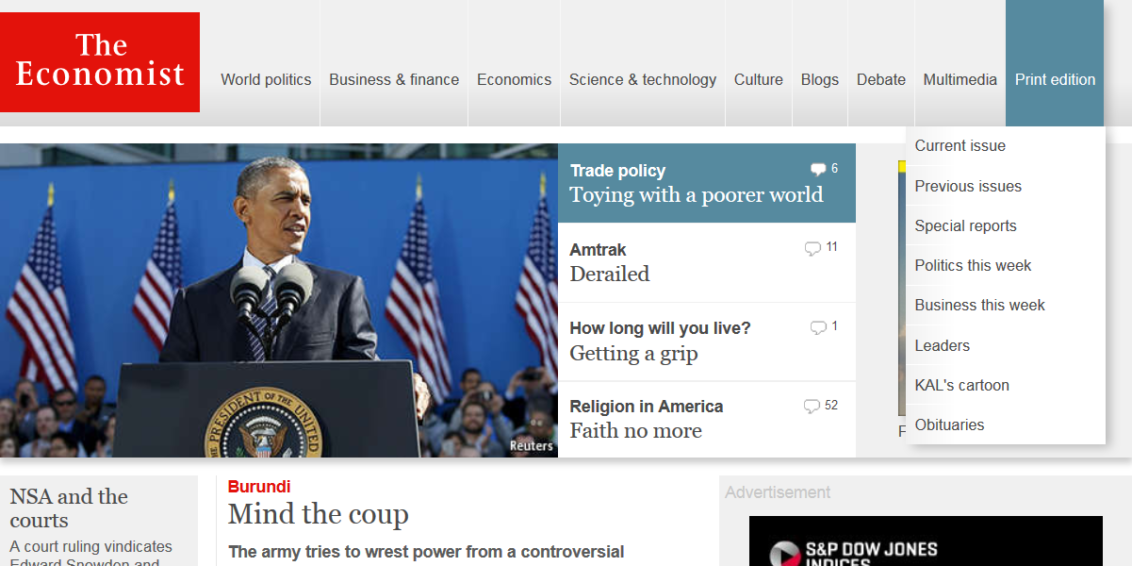The Economist digital magazine attracts 32 million page views per month, making it the envy of the publishing world. Find out the reasons for The Economist’s digital success with SHARLENE NAAIDOO, as she examines the unconventional methods setting this digital magazine apart.
The Economist has always strayed off the beaten path; their approach can be summed up by their 1990s slogan “The Economist – not read by millions of people”. It is this very tendency to throw out the rulebook has contributed to the phenomenal success of its digital magazine.
If there are rules at The Economist, they are rules that you will never find at any other magazine – digital or print. Here are five practices setting the Economist apart in the world of digital magazines.
Digital signatures a thing of the past with editorial anonymity
- Only under the most special of occasions does the name of the person writing an article appear in the Economist – like when an editor signs his/ her name on the occasion of departure from their role; a long-standing tradition at The Economist. Online blog pieces are signed with the initials of the writer and authors of stories are allowed to note their authorship only on their personal web sites. Does this imbue articles with greater insight and objectivity? Readers certainly seem to think so.
Digital Snob Appeal x 10
- The Economist believes in ‘feel good’ advertising; it makes their readers feel smarter and better than everyone else – like they are part of a special club. It’s the snob factor that no other digital magazine seems to be able to replicate. Their “White out of Red” advertising campaign was renowned for its witty phrases written in white on a plain red background, usually with The Economist in the bottom right-hand corner. For example: “I never read The Economist, Management trainee, Aged 42.”
- With this kind of advertising you run the risk of alienating potential customers but could win over potential customers by exploiting their insecurities about being left behind. In the case of The Economist the latter always seems to prevail.
The art of digital controversy
- It seems that The Economist regularly has difficulties with certain ruling parties; Singapore (the People’s Action Party), India whenever it depicts a map of Kashmir, Iran when the Economist published a map labelling the Persian Gulf simply as “Gulf”. Some of its magazine issues have been censored and some never reached certain subscribers, the Missouri Department of Corrections stopped prisoners reading one of their issues citing ‘threat to the security or discipline of the institution’ as a reason.
- Being controversial is par for the course these days, but it’s all about how you do it. The Economist lauds their ‘distinctive world view’ while maintaining a ‘what’s all the fuss about’ attitude that readers seem to lap up.
Keeping digital copy short and sweet
- Simply put, The Economist’s correspondents just give you the bare essential facts and a meaningful takeaway, whether the information came from their own reporting, the local press, or some obscure academic. They don’t care for the self-important opinions of experts and spokespeople. Call a spade a spade.
Being digitally exclusive pays off
- Almost in defiance of logic, The Economist has raised subscription and newsstand prices making it one of the most expensive magazines. While other magazines are failing and laying off staff, The Economist’s circulation has doubled in the past seven years and the digital magazine continues to grow from strength to strength.
In conclusion, The Economist seems to have all the right ingredients for success, namely deliberately creating a magazine not designed to appeal to the masses but which everyone wants to be seen reading, even if it comes at a higher price.
About the Author

Sharlene is a recent graduate of the Magazine Journalism Course at SA Writers College.













